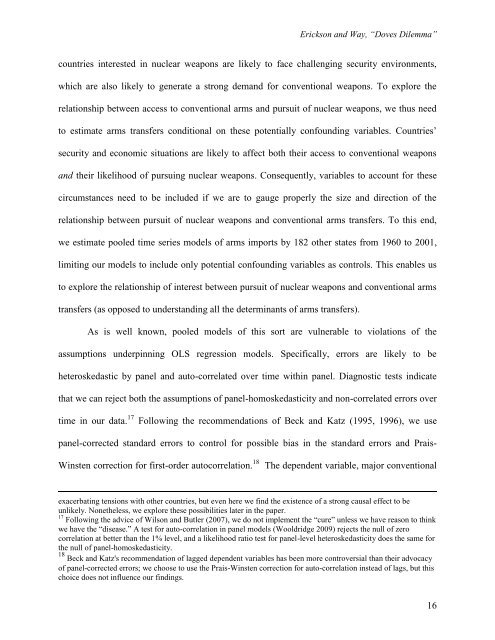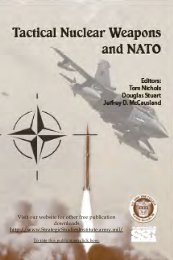Revisiting the Dove's Dilemma: - Program on Strategic Stability ...
Revisiting the Dove's Dilemma: - Program on Strategic Stability ...
Revisiting the Dove's Dilemma: - Program on Strategic Stability ...
Create successful ePaper yourself
Turn your PDF publications into a flip-book with our unique Google optimized e-Paper software.
Ericks<strong>on</strong> and Way, “Doves <str<strong>on</strong>g>Dilemma</str<strong>on</strong>g>”<br />
countries interested in nuclear weap<strong>on</strong>s are likely to face challenging security envir<strong>on</strong>ments,<br />
which are also likely to generate a str<strong>on</strong>g demand for c<strong>on</strong>venti<strong>on</strong>al weap<strong>on</strong>s. To explore <str<strong>on</strong>g>the</str<strong>on</strong>g><br />
relati<strong>on</strong>ship between access to c<strong>on</strong>venti<strong>on</strong>al arms and pursuit of nuclear weap<strong>on</strong>s, we thus need<br />
to estimate arms transfers c<strong>on</strong>diti<strong>on</strong>al <strong>on</strong> <str<strong>on</strong>g>the</str<strong>on</strong>g>se potentially c<strong>on</strong>founding variables. Countries’<br />
security and ec<strong>on</strong>omic situati<strong>on</strong>s are likely to affect both <str<strong>on</strong>g>the</str<strong>on</strong>g>ir access to c<strong>on</strong>venti<strong>on</strong>al weap<strong>on</strong>s<br />
and <str<strong>on</strong>g>the</str<strong>on</strong>g>ir likelihood of pursuing nuclear weap<strong>on</strong>s. C<strong>on</strong>sequently, variables to account for <str<strong>on</strong>g>the</str<strong>on</strong>g>se<br />
circumstances need to be included if we are to gauge properly <str<strong>on</strong>g>the</str<strong>on</strong>g> size and directi<strong>on</strong> of <str<strong>on</strong>g>the</str<strong>on</strong>g><br />
relati<strong>on</strong>ship between pursuit of nuclear weap<strong>on</strong>s and c<strong>on</strong>venti<strong>on</strong>al arms transfers. To this end,<br />
we estimate pooled time series models of arms imports by 182 o<str<strong>on</strong>g>the</str<strong>on</strong>g>r states from 1960 to 2001,<br />
limiting our models to include <strong>on</strong>ly potential c<strong>on</strong>founding variables as c<strong>on</strong>trols. This enables us<br />
to explore <str<strong>on</strong>g>the</str<strong>on</strong>g> relati<strong>on</strong>ship of interest between pursuit of nuclear weap<strong>on</strong>s and c<strong>on</strong>venti<strong>on</strong>al arms<br />
transfers (as opposed to understanding all <str<strong>on</strong>g>the</str<strong>on</strong>g> determinants of arms transfers).<br />
As is well known, pooled models of this sort are vulnerable to violati<strong>on</strong>s of <str<strong>on</strong>g>the</str<strong>on</strong>g><br />
assumpti<strong>on</strong>s underpinning OLS regressi<strong>on</strong> models. Specifically, errors are likely to be<br />
heteroskedastic by panel and auto-correlated over time within panel. Diagnostic tests indicate<br />
that we can reject both <str<strong>on</strong>g>the</str<strong>on</strong>g> assumpti<strong>on</strong>s of panel-homoskedasticity and n<strong>on</strong>-correlated errors over<br />
time in our data. 17 Following <str<strong>on</strong>g>the</str<strong>on</strong>g> recommendati<strong>on</strong>s of Beck and Katz (1995, 1996), we use<br />
panel-corrected standard errors to c<strong>on</strong>trol for possible bias in <str<strong>on</strong>g>the</str<strong>on</strong>g> standard errors and Prais-<br />
Winsten correcti<strong>on</strong> for first-order autocorrelati<strong>on</strong>. 18<br />
The dependent variable, major c<strong>on</strong>venti<strong>on</strong>al<br />
exacerbating tensi<strong>on</strong>s with o<str<strong>on</strong>g>the</str<strong>on</strong>g>r countries, but even here we find <str<strong>on</strong>g>the</str<strong>on</strong>g> existence of a str<strong>on</strong>g causal effect to be<br />
unlikely. N<strong>on</strong>e<str<strong>on</strong>g>the</str<strong>on</strong>g>less, we explore <str<strong>on</strong>g>the</str<strong>on</strong>g>se possibilities later in <str<strong>on</strong>g>the</str<strong>on</strong>g> paper.<br />
17 Following <str<strong>on</strong>g>the</str<strong>on</strong>g> advice of Wils<strong>on</strong> and Butler (2007), we do not implement <str<strong>on</strong>g>the</str<strong>on</strong>g> ―cure‖ unless we have reas<strong>on</strong> to think<br />
we have <str<strong>on</strong>g>the</str<strong>on</strong>g> ―disease.‖ A test for auto-correlati<strong>on</strong> in panel models (Wooldridge 2009) rejects <str<strong>on</strong>g>the</str<strong>on</strong>g> null of zero<br />
correlati<strong>on</strong> at better than <str<strong>on</strong>g>the</str<strong>on</strong>g> 1% level, and a likelihood ratio test for panel-level heteroskedasticity does <str<strong>on</strong>g>the</str<strong>on</strong>g> same for<br />
<str<strong>on</strong>g>the</str<strong>on</strong>g> null of panel-homoskedasticity.<br />
18 Beck and Katz's recommendati<strong>on</strong> of lagged dependent variables has been more c<strong>on</strong>troversial than <str<strong>on</strong>g>the</str<strong>on</strong>g>ir advocacy<br />
of panel-corrected errors; we choose to use <str<strong>on</strong>g>the</str<strong>on</strong>g> Prais-Winsten correcti<strong>on</strong> for auto-correlati<strong>on</strong> instead of lags, but this<br />
choice does not influence our findings.<br />
16








